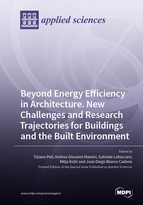Beyond Energy Efficiency in Architecture. New Challenges and Research Trajectories for Buildings and the Built Environment
A special issue of Applied Sciences (ISSN 2076-3417). This special issue belongs to the section "Energy Science and Technology".
Deadline for manuscript submissions: closed (28 February 2022) | Viewed by 39843
Special Issue Editors
Interests: performance-based design; energy efficiency in buildings; climate-responsive design; daylight; building envelope engineering; building technology; architecture
Special Issues, Collections and Topics in MDPI journals
Interests: building envelop innovation; user and comfort centric design; technology transfer; building overheating and energy efficiency
Special Issues, Collections and Topics in MDPI journals
Interests: solar energy; solar potential; daylight; urban climate; building technology; parametric modeling; building and neighborhood energy design
Special Issues, Collections and Topics in MDPI journals
Interests: daylighting, building energy performance; bioclimatic design; building envelope performance; high-performance buildings; climate change and building performance; building sustainability
Special Issues, Collections and Topics in MDPI journals
Interests: building-human interaction; visual comfort; thermal comfort; smart buildings; building operation performance
Special Issues, Collections and Topics in MDPI journals
Special Issue Information
Dear Colleagues,
Over the last few decades, energy efficiency and lower environmental impact of buildings (during their life cycle) have been at the forefront of building design, geared towards the goal of low carbon energy transition. Both fundamental and applied research has seen the expansion of innovative architectural concepts, new uses, as well as new building operation models, resulting in the development of cutting-edge and high-performance building energy and management systems, building technologies, materials, and components. Significant progress has also been made in the design approach with the introduction of BIM, positively influencing the management of the operational phase of the building with continuous monitoring and commissioning, for real time and post-occupancy energy efficiency evaluation. Combined, these approaches have reduced the performance gap between designed and real operational energy performance through mitigation of modeling uncertainty (due to the building use model, tools used for analysis, and boundary conditions in the climatic and environmental context).
Research and development of innovative solutions have received a further boost related to the need for climate change mitigation and adaptation, and occupant comfort and health. This context has contributed to:
- High-performance, energy-efficient, and dynamic/adaptive solutions for building envelope and plant integration;
- Architectural integration of highly efficient renewable energy production plant solutions;
- New multiscale design approaches for energy- and occupant-centered efficiency (smart living/smart building/smart district/smart communities);
- Tailor-made solutions related to parametric design and multiobjective optimization, with a particular focus on performance-based approaches; and,
- The construction of multiscale, and multivariable, analysis metrics and models.
The current digital and technological transformation is once again rapidly changing the reference/benchmark scenario (e.g., BIM digital twin) and the energy efficiency of buildings, districts, and cities; however, it is a necessary (though not sufficient) condition to respond to global challenges that go as far as the climate emergency spreads. We are experiencing the boom of a performance-based, BIM, and parametric-driven design era, where controlling certain processes such as design, production, construction, management, maintenance, transformation, and decommissioning is generating added value, particularly in respect of building energy efficiency and well-being.
This Special Issue aims to focus on frontier research in the construction sector and to trace the outlines of emerging trends. What are the new reference/benchmark scenarios? What are the new challenges and frontiers of research? What are their impacts on buildings, their occupants, and the built environment?
Some keywords can be used to characterize the ongoing low-energy, digital, and technological transformation of the built environment: clean construction and clean energy production; data-driven design and multiscale approach; cognitive and climate-responsive buildings, and occupant-centric building design and interaction. All these transformations boost innovation when combined with new approaches and advanced design/construction tools, new production technologies and tools for process and building management; and sensor integration, data availability, and new communication technologies.
In order to understand the ongoing changes and their impacts, we invite researchers to contribute in this Special Issue with distinguished original features concerning the application of data-driven sustainable and resilient architectural design and building engineering, performance-based multiobjective design to achieve energy efficiency, architectural integration, and occupant-centric comfortable, cognitive and climate-resilient buildings. We are interested in advanced building materials, lifecycle building design and environmental evaluation, as well as components that assist the formulation of digitalized, cognitive and clean construction processes.
Contributions can include but are not limited to the following topics:
- Experimental and modeling studies (energy efficiency, comfort, human health, etc.);
- Implementation and development of high-performance building technologies and components;
- Conservation/refurbishment/improvement/mitigation and adaptation strategies for various contexts (climate, environment, and use); and,
- Forecasting scenarios of energy/environmental consumption and/or impacts utilizing multiscale (component, building, neighborhood, and city), multicriteria and multiobjective analysis.
We look forward to receiving your contributions.
Prof. Dr. Tiziana Poli
Prof. Dr. Andrea Giovanni Mainini
Prof. Dr. Gabriele Lobaccaro
Prof. Dr. Mitja Košir
Dr. Juan Diego Blanco Cadena
Guest Editors
Manuscript Submission Information
Manuscripts should be submitted online at www.mdpi.com by registering and logging in to this website. Once you are registered, click here to go to the submission form. Manuscripts can be submitted until the deadline. All submissions that pass pre-check are peer-reviewed. Accepted papers will be published continuously in the journal (as soon as accepted) and will be listed together on the special issue website. Research articles, review articles as well as short communications are invited. For planned papers, a title and short abstract (about 100 words) can be sent to the Editorial Office for announcement on this website.
Submitted manuscripts should not have been published previously, nor be under consideration for publication elsewhere (except conference proceedings papers). All manuscripts are thoroughly refereed through a single-blind peer-review process. A guide for authors and other relevant information for submission of manuscripts is available on the Instructions for Authors page. Applied Sciences is an international peer-reviewed open access semimonthly journal published by MDPI.
Please visit the Instructions for Authors page before submitting a manuscript. The Article Processing Charge (APC) for publication in this open access journal is 2400 CHF (Swiss Francs). Submitted papers should be well formatted and use good English. Authors may use MDPI's English editing service prior to publication or during author revisions.
Keywords
- building resilience and sustainability
- climate change adaptation
- energy efficiency
- smart buildings
- user-centered design
- performance-based design
- digital twin
- architectural integration
- building technology
- innovation










